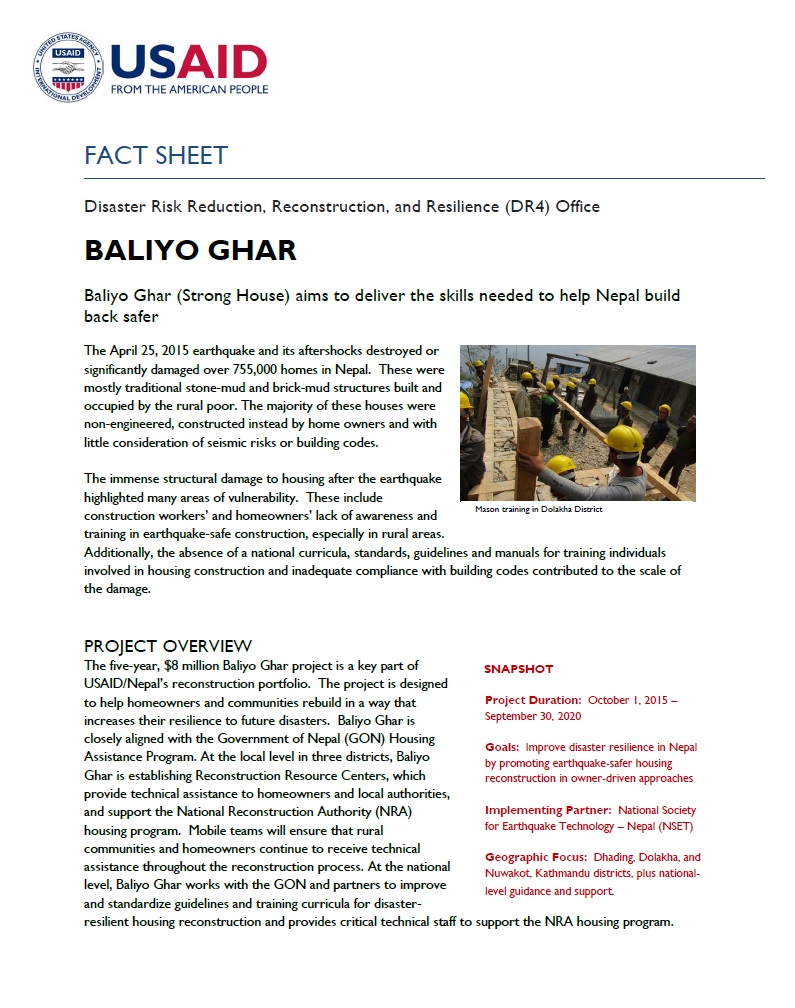![]() (126k) BALIYO GHAR
(126k) BALIYO GHAR
Disaster Risk Reduction, Reconstruction, and Resilience (DR4) Office
BALIYO GHAR
Baliyo Ghar (Strong House) aims to deliver the skills needed to help Nepal build back safer
The April 25, 2015 earthquake and its aftershocks destroyed or significantly damaged over 755,000 homes in Nepal. These were mostly traditional stone-mud and brick-mud structures built and occupied by the rural poor. The majority of these houses were non-engineered, constructed instead by home owners and with little consideration of seismic risks or building codes.
The immense structural damage to housing after the earthquake highlighted many areas of vulnerability. These include construction workers’ and homeowners’ lack of awareness and training in earthquake-safe construction, especially in rural areas. Additionally, the absence of a national curricula, standards, guidelines and manuals for training individuals involved in housing construction and inadequate compliance with building codes contributed to the scale of the damage.
PROJECT OVERVIEW
The five-year, $8 million Baliyo Ghar project is a key part of USAID/Nepal’s reconstruction portfolio. The project is designed to help homeowners and communities rebuild in a way that increases their resilience to future disasters. Baliyo Ghar is closely aligned with the Government of Nepal (GON) Housing Assistance Program. At the local level in three districts, Baliyo Ghar is establishing Reconstruction Resource Centers, which provide technical assistance to homeowners and local authorities, and support the National Reconstruction Authority (NRA) housing program. Mobile teams will ensure that rural communities and homeowners continue to receive technical assistance throughout the reconstruction process. At the national level, Baliyo Ghar works with the GON and partners to improve and standardize guidelines and training curricula for disaster-resilient housing reconstruction and provides critical technical staff to support the NRA housing program.
PROJECT ACTIVITIES
Develop Improved and Standardized Training Curricula and Procedures:
Baliyo Ghar works closely with GON counterparts – such as the Department of Urban Development and Building Construction and the Council for Technical Education and Vocational Training – to integrate earthquake-safe construction principles and technology into existing training materials. The project is improving and standardizing the training curricula for masons and other construction workers country wide. With GON counterparts, Baliyo Ghar is working to establish a formal system for skills testing and mason certification – both critical to professionalizing the field of masonry.
Train Masons and Engineers on Disaster-Resilient Construction Technology:
A key component of Baliyo Ghar is the training of masons, engineers, and other building tradespeople in earthquake-resistant construction technology and techniques. Courses will be conducted at district and local levels for both existing and new construction workers. With a larger and better trained cadre of construction professionals, earthquake-affected households will have access to the human resources they need to rebuild safer homes.
Enhance Public Awareness and Adoption of Disaster-Resilient Construction Methods:
Baliyo Ghar is training and deploying mobile teams to conduct orientation sessions for homeowners at the local level as well as to provide technical assistance to masons and homeowners during the reconstruction process, which is expected to take several years and will require sustained technical support. District and local resource centers and demonstration housing will provide technical assistance and support for affected communities. The program is producing a variety of tools for education and outreach on safer construction practices, including mass media public awareness campaigns via radio, television, social and print media.
PLANNED RESULTS
- 7 Reconstruction Resource Centers established to provide training and technical assistance support for housing reconstruction
- 600 engineers and junior engineers trained on disaster-resilient construction technology
- 7,200 masons and other building tradespeople trained on disaster-resilient building construction
- 600 social mobilizers trained on disaster-resilient building construction and mobilization of communities to use construction practices that build safer homes
- 400 GON officials trained on safer construction practices
- 180,000 individuals oriented in earthquake-safety awareness campaigns








Comment
Make a general inquiry or suggest an improvement.